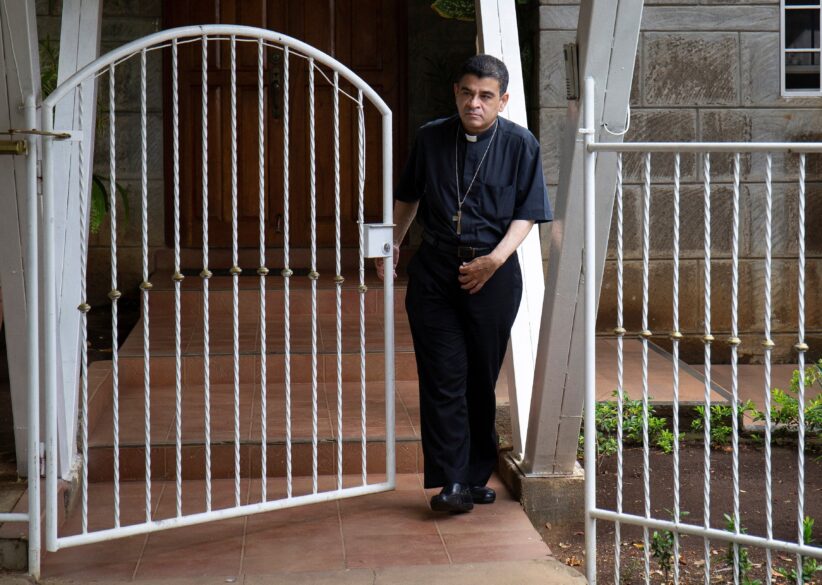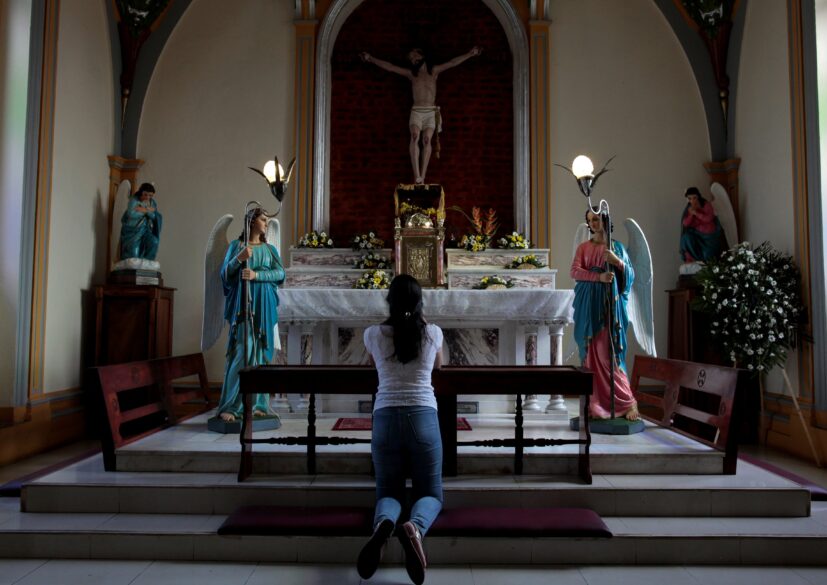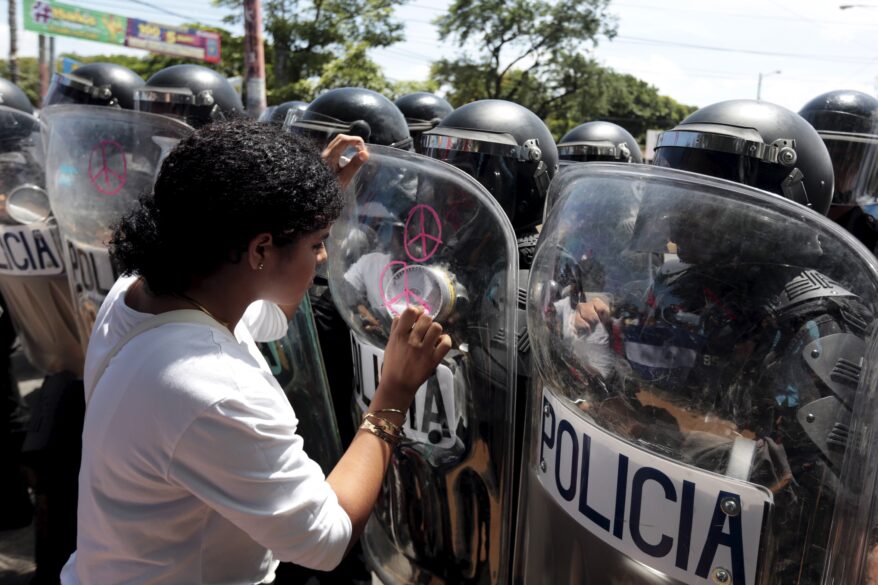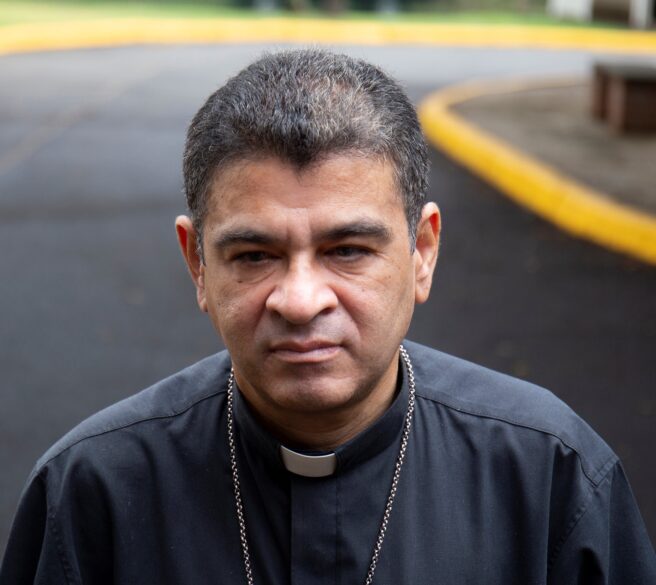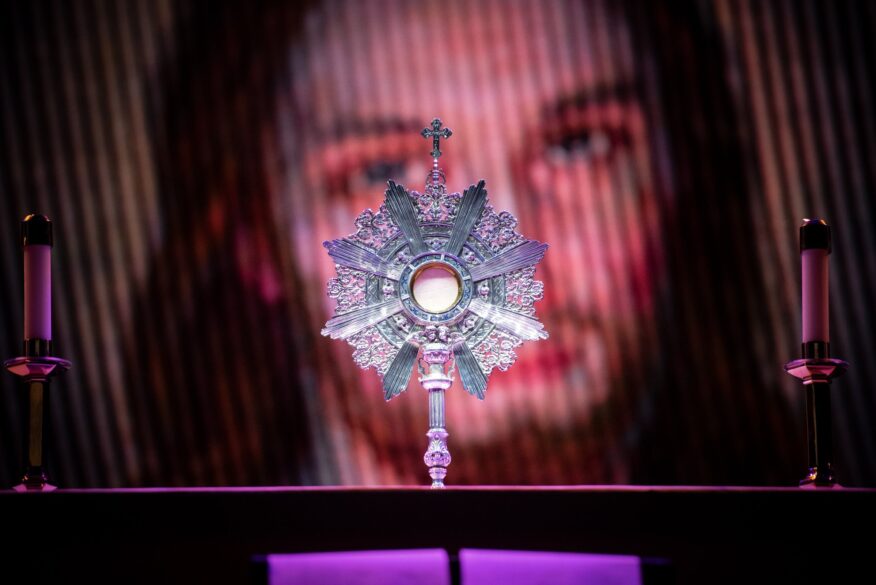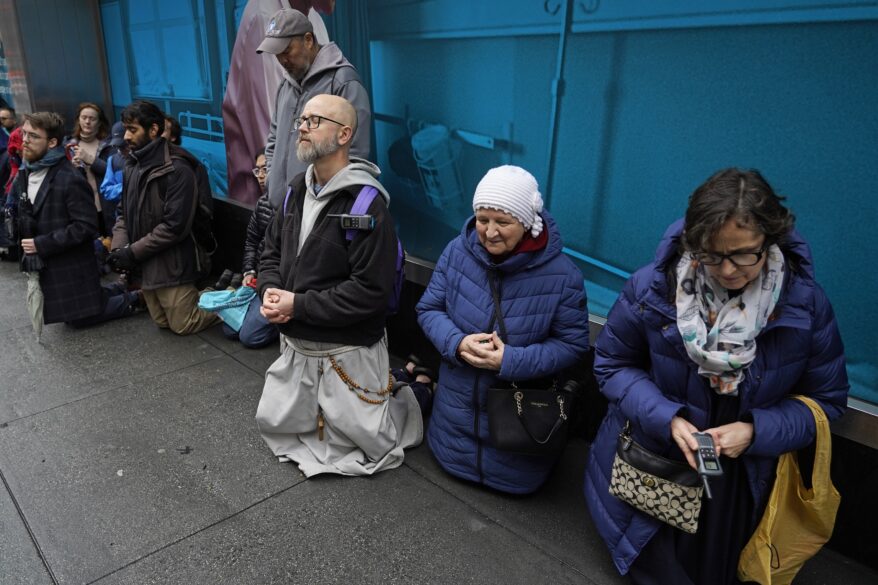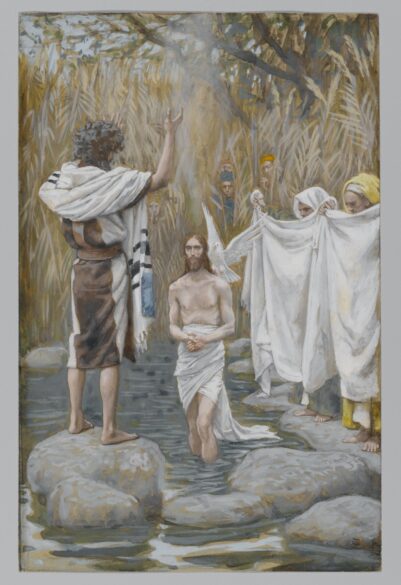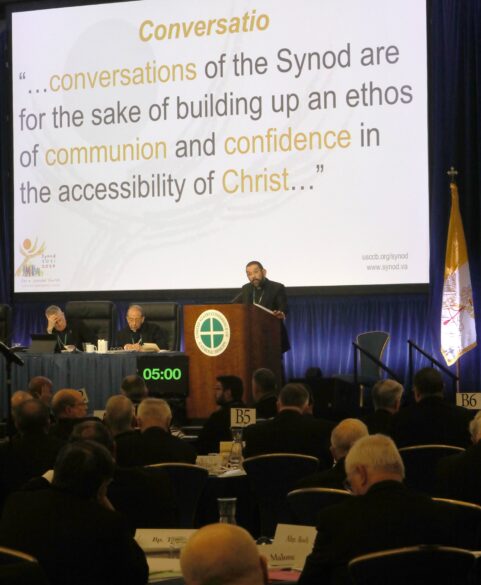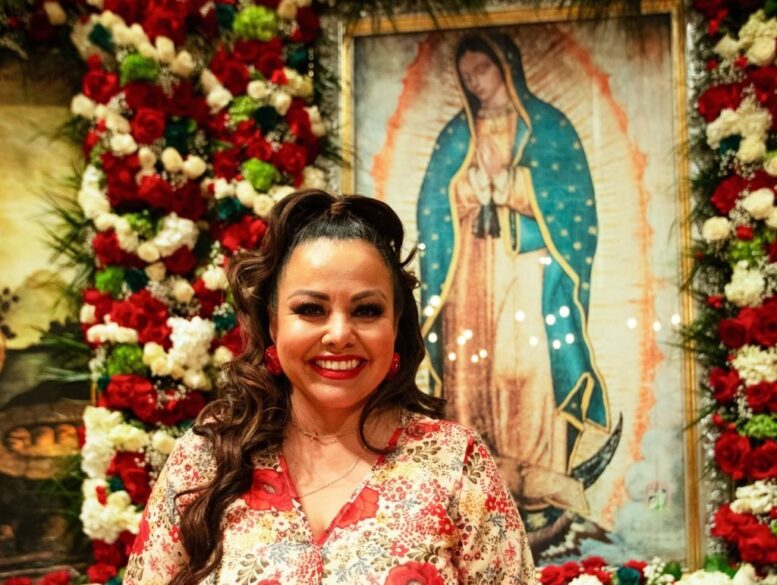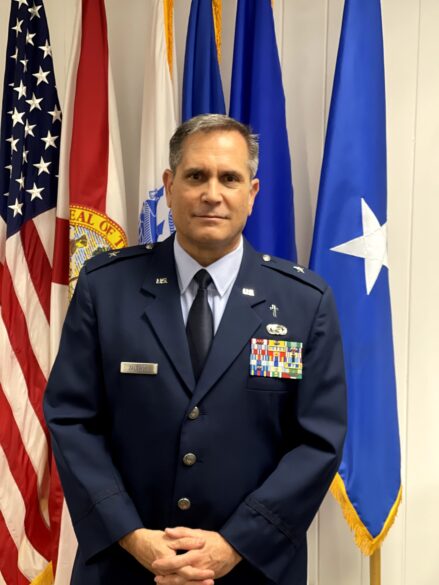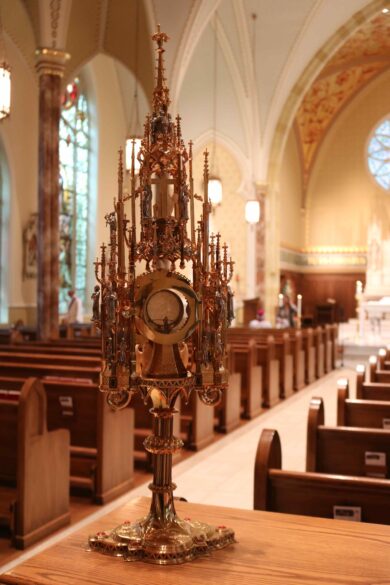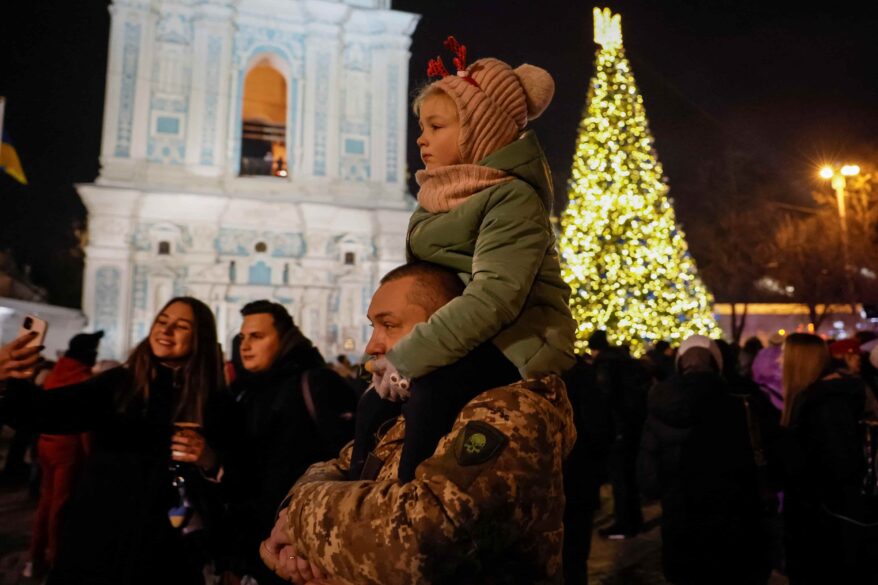Por María Reina Donnelly
La escultora Mary Davidson y su co-artista y esposo, el Dr. Kenneth Davidson, observaron cómo se erigía el “Cristo Negro” en la pared detrás del altar de la Iglesia Católica del Sagrado Corazón en Camden, Mississippi. De repente la voz de un feligrés le habló a Mary, casi en un susurro. Era 2007.
“Espero que algún día crees una estatua de la hermana Thea Bowman”, dijo la voz.
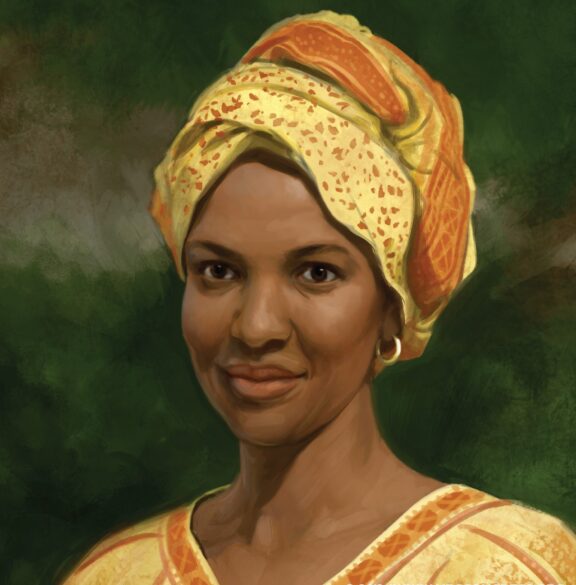
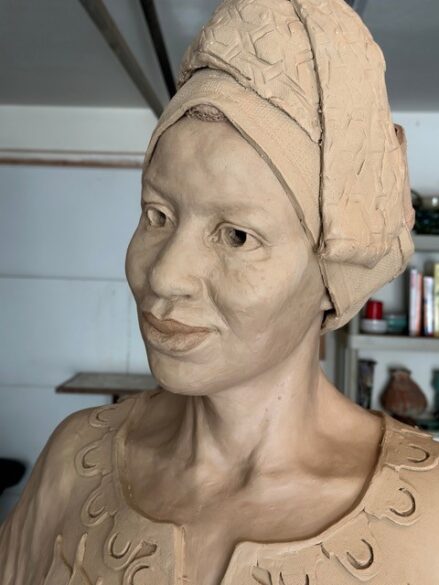
JACKSON – Una composición de fotos ilustra el rostro de la Hemana Thea Bowman usando su característico turbante, que fue reproducido como parte de su atuendo en la estatua de broce creada por la escultura y artista Mary Davinson. (Foto de Mississippi Catholic y August Taconi)
Era la primera vez que Mary Davidson oía hablar de la hermana Thea Bowman. Sin embargo, al ser alertada del nombre, empezó a prestar atención a los artículos sobre la hermana Thea.
Se enteró de que la hermana Thea, como ella, era nativa del Misisipi y que era la única afroamericana que ingresó en la congregación religiosa de monjas exclusivamente blancas, las Hermanas Franciscanas de la Adoración Perpetua en La Crosse, Wisconsin. Además, se enteró de que la hermana Thea era nieta de un esclavo; y que se convirtió al catolicismo a los nueve años debido al origen religioso protestante de su familia. Thea se había inspirado en la bondad y el amor demostrados por las Hermanas Franciscanas que habían venido a servir a su comunidad en Canton, Mississippi, al iniciar una escuela para niños afroamericanos.
Bertha, su nombre al nacer, era el tesoro del Dr. Theon Edward Bowman, médico, y de su madre Mary Esther Coleman Bowman, educadora y ama de casa. A una edad temprana transfirieron a Bertha a la Escuela Católica del Santo Niño Jesús, donde las Hermanas Franciscanas administraban y enseñaban. Como educadores, los padres de Bertha estaban insatisfechos con el nivel de la educación en las escuelas públicas segregadas de Canton.
Bertha, una niña brillante, avanzó rápidamente en la Escuela Holy Child, se saltó grados y se destacó en todos los aspectos del plan de estudios. A los 15 años, decidió que quería dejar su amado hogar en Canton, Mississippi, y unirse a la Congregación de las Hermanas Franciscanas de la Adoración Perpetua en La Crosse, Wisconsin.
Al principio, esta idea no les cayó bien a los padres de Bertha. Después de todo, Bertha era su única hija. Vecinos y amigos la llamaban “hija de viejos”. Cuando nació, la Dra. Bowman había comprado una costosa botella de champán para abrirla en su boda. La botella de champán, aún sin abrir, se conserva en el Museo Thea de Canton, Mississippi.
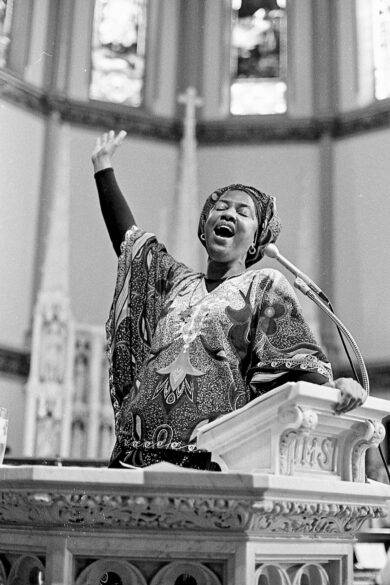
Davidson y su esposo Ken recibieron el encargo de crear muchas obras después de ese momento en la Iglesia del Sagrado Corazón en Camden. Entre ellos: un busto del obispo Joseph Lawson Howze, un obispo afroamericano que fue el primer obispo de la diócesis de Biloxi.
Entre creaciones artísticas, Mary y Ken impartieron clases de tallado en piedra, fundición de bronce y escultura en talleres durante 20 veranos en Wisconsin y Nueva Jersey. También impartieron clases de diseño, cerámica y escultura en Gulfport, Mississippi.
Aunque estuvo involucrada en muchos proyectos artísticos, Mary Davidson nunca olvidó esa mano en su hombro en Camden, Mississippi, donde escuchó por primera vez hablar de la hermana Thea Bowman.
Un día tranquilo de julio de 2022, Davidson se puso en contacto con una amiga que, según recordaba, creció con la hermana Thea en su ciudad natal de Canton, Mississippi. Su amiga la puso en contacto con Mary Woodward, Canciller de la Diócesis de Jackson, quien sirve como enlace diocesano para el proceso canónico de la causa de canonización de la hermana Thea.
El resto es una historia inspiradora que ha resultado en la creación por parte de Davidson de una estatua de arcilla de casi seis pies de la hermana Thea, que actualmente está siendo preparada por artesanos para fundición de bronce en Inferno Art Foundry en Union City, Georgia.
Antes de encargarle a Davidson la creación de la estatua, el proyecto tuvo que ser financiado. Buscando en su memoria un patrocinador potencial que pudiera estar interesado en apoyar un proyecto de este tipo, Davidson recordó que ella había enseñado al Arzobispo Thomas Rodi de la Arquidiócesis de Mobile en Alabama, cuando él estaba en octavo grado en la Escuela Nuestra Señora de Lourdes en Nueva Orleans. En ese momento, Davidson era conocida como la Hermana Mary Augustine, O.P., una hermana dominicana.
“Era un chico difícil y típico”, recuerda Davidson. El arzobispo Rodi está de acuerdo. “Definitivamente pusimos a prueba su paciencia y determinación en muchas ocasiones”, dijo.
Al ser contactado por Davidson sobre la propuesta de crear una estatua de bronce de la hermana Thea Bowman, el arzobispo Rodi se mostró muy interesado. Como ex obispo de la diócesis de Biloxi, el arzobispo Rodi estaba muy familiarizado con la obra de Davidson, especialmente el busto del obispo Howze.
El Arzobispo Rodi se puso en contacto con el Obispo Joseph Kopacz de la Diócesis de Jackson para ofrecerle su apoyo para que el proyecto se hiciera realidad. Con la ayuda de todos los obispos de la Provincia de Mobile (el Arzobispo Rodi, el Obispo Louis Kihneman de Biloxi, el Obispo Stephen Raica de Birmingham y fondos del patrimonio de su predecesor, el Obispo Joseph Latino), el Obispo Kopacz pudo encargar a Davidson la creación de la estatua de la hermana Thea.

SAUCIER – Mary Davidson hace un ajuste a la estatua de arcilla de la hermana Thea Bowman en su estudio. El modelo pronto se colocará en bronce. (Foto de August Taconi)
Por tanto, la estatua es un regalo único y simbólico de los obispos y diócesis de Mississippi y Alabama.
Cabe señalar que en esta fase crítica del desarrollo de una propuesta para crear una estatua de bronce de la hermana Thea, Ken, el socio artístico y esposo de toda la vida de Davidson, enfermó. Le diagnosticaron el síndrome del cuerpo de Lewy, una enfermedad debilitante y mortal que le dejó sólo meses o semanas de vida. Entonces, mientras contemplaba la firma de un contrato en marzo de 2023, confió en su fe para embarcarse en un proyecto desafiante, sin la asistencia física y emocional de alguien en quien había confiado durante toda su vida.
Además, le había prometido a Ken que cuidaría de él. Y así fue que Davidson aprovechó los pocos momentos que le quedaban para darle vida al rollo de arcilla que yacía ante ella. Mientras luchaba por llevar a Ken al médico, vestirlo y alimentarlo, respondiendo a cada una de sus llamadas de ayuda (ya que su mente se estaba deteriorando junto con su cuerpo), ella hundió sus dedos artríticos en la arcilla y oró. El miércoles 23 de agosto de 2023, Ken murió.
El amigo y director espiritual de Davidson, el padre George Murphy, que conocía tanto a Ken como a Davidson, la ayudó en los días oscuros que se avecinaban. Ella había firmado un contrato. Al darse cuenta de que necesitaba ayuda para continuar con el proyecto, solicitó la ayuda de un antiguo alumno de una clase que había impartido en Wisconsin.
El 21 de octubre de 2023, Davidson completó la versión en arcilla de la estatua. Invitó al Comité de la Estatua de la Hermana Thea a visitar su estudio en Saucier, Mississippi, para ver la estatua y dar su aprobación antes de proceder a la etapa de bronceado de la estatua. Woodward dirigió el comité y trajo consigo a Fabvienen Taylor, vieja amiga de la hermana Thea y ex fotoperiodista de Mississippi Catholic. Llegaron al estudio de Davidson para ver la estatua de arcilla casi terminada por primera vez el sábado 16 de octubre de 2023.
Woodward registró sus reflexiones de ese momento, “A medida que nos acercábamos al garaje/estudio donde nos esperaba la estatua, recuerdo que me sentí atraído por el aura de la creación, similar a cómo un imán atrae el metal hacia sí mismo”, dijo Woodward. “Cuanto más la miraba, más me conmovía la complejidad del momento. Podía sentir una lágrima bajando poco a poco por mi mejilla.
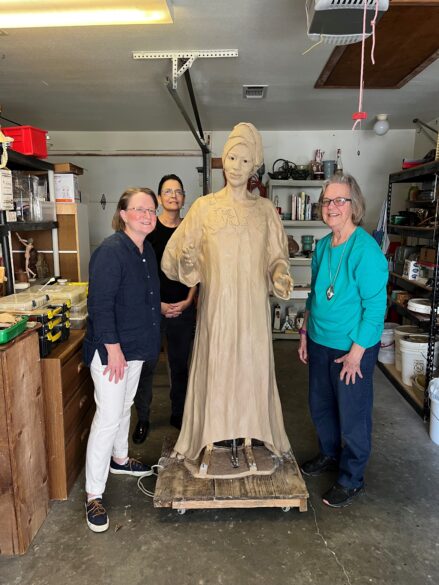
SAUCIER – El 16 de octubre de 2023, (i-d) Mary Woodward, canciller de la Diócesis y Fabvienen Taylor, vieja amiga de la hermana Thea y ex fotoperiodista de Mississippi Catholic visitan a la escultora Mary Davinson y posan junto a la estatua de arcilla de la hermana Thea Bowman en el estudio de la artista. El modelo pronto se colocará en bronce. (Foto de August Taconi)
“Fue un honor trabajar en el proyecto con Mary: compartir maravillosos almuerzos con ella y Ken y saber la tremenda pérdida que estaba soportando; Sabía que la hermana Thea, Ken y el Señor le estaban dando la fuerza para darle vida a la estatua, porque de hecho la estatua parecía moverse y respirar. Las manos, diseñadas a partir de una fotografía de la hermana Thea que a Mary y a mí nos encantó, dan la bienvenida al espectador a su espacio místico”, concluyó Woodward.
Taylor también quedó impresionado por el molde de arcilla. “La estatua de la hermana Thea captura su acercamiento acogedor, vibrante y amoroso a todas las personas. Las manos extendidas y la sonrisa evocan a la hermana Thea que recuerdo: una mujer de Dios rebosante de un deseo poderoso y una energía incesante para inspirar y empoderar a todos los que encontraba con el conocimiento y la comprensión del amor inquebrantable e integral de Dios por ellos,” ella añadió.
El 29 de octubre de 2023, Mary Davidson abrió su estudio para que los invitados vieran la estatua. Algunos estaban familiarizados con su trabajo. Algunos no. Las críticas fueron entusiastas. Los comentarios variaron desde “¡Las manos!” “¡Los ojos!” “Siento que me está invitando a abrazarla.”
Días después, el artesano de Inferno Art Foundry de Union City, Georgia, llegó para formar un molde a partir de la estatua de arcilla. El molde se llevó a la fundición en Georgia para pasar por varias etapas del proceso antes de finalmente verter el bronce para formar la etapa final: una estatua de bronce de la Sierva de Dios Hermana Thea Bowman, FSPA.
Según el obispo Kopacz, el plan actual es albergar la estatua de bronce en la Catedral de San Pedro Apóstol en Jackson hasta que se pueda desarrollar un santuario permanente como parte del proceso de canonización. La ceremonia de instalación tendrá lugar en algún momento después de Semana Santa esta primavera de 2024.
“Estamos agradecidos con todos aquellos que han ayudado en este maravilloso proyecto, especialmente la Sra. Davidson, quien a pesar de su tragedia personal ha creado una increíble obra de arte para honrar el legado y el espíritu de la Sierva de Dios, la hermana Thea Bowman“, dijo el obispo Kopacz. “Tengo muchas ganas de que llegue a la Catedral,” concluyó.
(Mary Queen Donnelly, contemporánea de la hermana Thea Bowman, FSPA, nació y creció en la misma ciudad de Canton, Mississippi, y siguió siendo amiga de la hermana Thea durante toda su vida hasta la muerte de Thea el 30 de marzo de 1990. Donnelly ha publicado varios artículos sobre su amiga. Últimamente, Donnelly publicó y produjo Thea’s Turn, una obra de teatro basada en la vida de la hermana Thea Bowman.)

